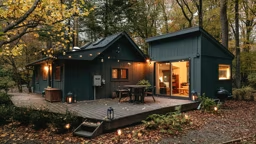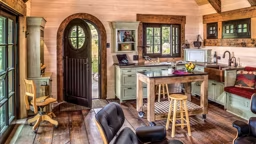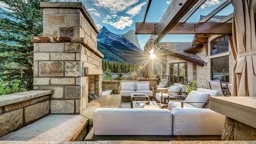Sister Act
Summertime, and the livin’ is easy for Jim and Mary Ann Welzbacher. They can kick back at their Lake Ozark, Mo., vacation home and watch the bass jump. But it wasn’t always that way.
Sure, the painted deck looked nice when the couple, along with Mary Ann’s sister Judy and her husband Tom Vernier, bought the cabin in 1993. But soon, it was giving off bad vibes. Literally. “If you were drinking a glass of wine,” recalls Mary Ann, “when someone walked across, it would bounce.” It didn’t help that the lumber was untreated, and the cedar posts wicked water from the lake.
Even with four people scraping and painting, the deck was a hassle. “Each year, it looked worse,” she sighs. “There were spots where the paint had blistered and peeled off. It was silly to go down every spring to get it ready for summer, and by fall, it looked bad.”
A low-maintenance replacement was needed, but which one? These days, there are scores of composites on the market (see sidebar). A visit to a spring lakehome show in March sealed the deal for the Welzbachers in favor of AZEK, a stain- and slip-resistant vinyl material.
Last summer, Dan Kelly of Deck X-perts in nearby Linn Creek, Mo., installed the new 900-square foot deck and steps leading down to the lake. A quarter of Kelly’s business is replacement decks. Of those, 90 percent are synthetic, he says. “People are upgrading to protect their investment.” Summers are humid in these parts, and a slippery green algae is the bane of wood decks.
The deck was finished in time for all four sisters, including Carol Reiter and Peggy Bauman, and their families to celebrate the 95th birthday of their mother, Elizabeth McElligott. The new deck can safely hold a crew of 15 or 20.
Fran Sigurdsson likes shuffling the deck, especially when she’s winning at crazy rummy.
Summertime, and the livin’ is easy for Jim and Mary Ann Welzbacher. They can kick back at their Lake Ozark, Mo., vacation home and watch the bass jump. But it wasn’t always that way.
Sure, the painted deck looked nice when the couple, along with Mary Ann’s sister Judy and her husband Tom Vernier, bought the cabin in 1993. But soon, it was giving off bad vibes. Literally. “If you were drinking a glass of wine,” recalls Mary Ann, “when someone walked across, it would bounce.” It didn’t help that the lumber was untreated, and the cedar posts wicked water from the lake.
Even with four people scraping and painting, the deck was a hassle. “Each year, it looked worse,” she sighs. “There were spots where the paint had blistered and peeled off. It was silly to go down every spring to get it ready for summer, and by fall, it looked bad.”
A low-maintenance replacement was needed, but which one? These days, there are scores of composites on the market (see sidebar). A visit to a spring lakehome show in March sealed the deal for the Welzbachers in favor of AZEK, a stain- and slip-resistant vinyl material.
Last summer, Dan Kelly of Deck X-perts in nearby Linn Creek, Mo., installed the new 900-square foot deck and steps leading down to the lake. A quarter of Kelly’s business is replacement decks. Of those, 90 percent are synthetic, he says. “People are upgrading to protect their investment.” Summers are humid in these parts, and a slippery green algae is the bane of wood decks.
The deck was finished in time for all four sisters, including Carol Reiter and Peggy Bauman, and their families to celebrate the 95th birthday of their mother, Elizabeth McElligott. The new deck can safely hold a crew of 15 or 20.
Fran Sigurdsson likes shuffling the deck, especially when she’s winning at crazy rummy.
Going Against the Grain
Synthetic or compostite wood decking is gaining ground these days. And while there’s no perfect product that’s stain and fade-free, acknowledges Barry Streett, some come pretty darn close. “Every year there’s something new. We’re probably in the fourth or fifth generation of material.”
The two main types are:
Composite – a combination of two or more substances, typically plastic and wood “flour” (ground-up scrap and sawdust).
Early versions looked fake; today’s simulate real wood in tone and texture. With over 50 brands to choose from, consider profile (solid, hollow, ribbed), type of plastic, fasteners (nails, screws, hidden) and warranty. EverGrain has a unique deep grain and comes in eight colors with a 25-year limited warranty against rotting, splintering, splitting and termites.
Vinyl – Polyvinylchloride (PVC) decking with no wood filler.
The hollow profile has two PVC layers: an impact-resistant outer with UVinhibitor, and a thicker inner with additives for strength. Consider texture, code approval in your locale and availability of matching trim.
Solid or “cellular” PVC has half the density of regular PVC with the workability of wood. This material is a recent industry breakthrough (tiny air bubbles are created by a foaming extrusion process), so there are only a few brands on the scene. AZEK resists rot, splinters and termites; it comes in four colors with a limited lifetime warranty.
Confused? Do the research before interviewing contractors, advises Dan Kelly. Go to deck specialty stores and feel the material. Consider aesthetics and cost. Synthetics are more expensive than pressuretreated wood (AZEK runs about $5 per square foot, says Kelly, while EverGrain is about $4), but are easier to maintain and clean. Is the material easy to work? Top of the line drills or special screws can drive costs higher. Once you’ve narrowed your list down to two or three brands you like, find reputable contractors and get bids.
Synthetic or compostite wood decking is gaining ground these days. And while there’s no perfect product that’s stain and fade-free, acknowledges Barry Streett, some come pretty darn close. “Every year there’s something new. We’re probably in the fourth or fifth generation of material.”
The two main types are:
Composite – a combination of two or more substances, typically plastic and wood “flour” (ground-up scrap and sawdust).
Early versions looked fake; today’s simulate real wood in tone and texture. With over 50 brands to choose from, consider profile (solid, hollow, ribbed), type of plastic, fasteners (nails, screws, hidden) and warranty. EverGrain has a unique deep grain and comes in eight colors with a 25-year limited warranty against rotting, splintering, splitting and termites.
Vinyl – Polyvinylchloride (PVC) decking with no wood filler.
The hollow profile has two PVC layers: an impact-resistant outer with UVinhibitor, and a thicker inner with additives for strength. Consider texture, code approval in your locale and availability of matching trim.
Solid or “cellular” PVC has half the density of regular PVC with the workability of wood. This material is a recent industry breakthrough (tiny air bubbles are created by a foaming extrusion process), so there are only a few brands on the scene. AZEK resists rot, splinters and termites; it comes in four colors with a limited lifetime warranty.
Confused? Do the research before interviewing contractors, advises Dan Kelly. Go to deck specialty stores and feel the material. Consider aesthetics and cost. Synthetics are more expensive than pressuretreated wood (AZEK runs about $5 per square foot, says Kelly, while EverGrain is about $4), but are easier to maintain and clean. Is the material easy to work? Top of the line drills or special screws can drive costs higher. Once you’ve narrowed your list down to two or three brands you like, find reputable contractors and get bids.
When the deck’s a wreck, what’s a cabin owner to do?
You could, of course, replace old lumber with new. But then, you’d still have to deal with the sealing and staining, the sanding and scraping. Let’s face it: Wood decks don’t last forever. And the older they get, the more TLC they need. That’s time you could spend on the lake or the slopes, instead of on your knees.
Which is why, the second time around, more vacation home owners are opting for manmade, composite or synthetic decking. Consider these two beauties:
Rocky Mountain High
The log cabin in Silverthorne, Colo., came with a small upper deck. It was old and poorly supported, recalls Linda Martinez, who purchased the mountainside retreat with son Christopher in 2001. A hot tub monopolized the deck space, and the cedar needed oiling and painting. But oh, the views!
Christopher, an avid snowboarder, could eye the runs at Keystone Ski Resort to the east. (The cabin is also within a half hour of Vail, Breckenridge, Loveland, and Arapahoe Basin ski areas.) Scenic high country vistas beckoned to Linda and husband Bob, who love to hike and golf. And looking downhill, the family could see where I-70 crosses the Continental Divide via the Eisenhower Memorial Tunnel (at 11,013 feet, the world’s highest tunnel).
Alas, someone bought the site below and built out into open space, blocking the view. To the rescue: Barry Streett of Rolling Ridge Decks in nearby Evergreen, Colo. In 2007, Streett designed and built a multi-level deck that not only restored the vistas, it expanded the cabin’s outdoor living space. The decking, a brand named EverGrain, is a moisture-resistant composite of hardwood fiber and plastic.
Of the roughly 100 replacement decks a year that Streett’s company builds in Summit County’s resort towns, 85 to 90 percent are composite, he says. “It’s a maintenance issue more than anything.”
In fair weather, the family barbeques on the deck. Linda and Bob frequently entertain golf friends and Bob’s extended family. When the snow flies, it’s time for Christopher and his ski buddies to establish “base camp.”
You could, of course, replace old lumber with new. But then, you’d still have to deal with the sealing and staining, the sanding and scraping. Let’s face it: Wood decks don’t last forever. And the older they get, the more TLC they need. That’s time you could spend on the lake or the slopes, instead of on your knees.
Which is why, the second time around, more vacation home owners are opting for manmade, composite or synthetic decking. Consider these two beauties:
Rocky Mountain High
The log cabin in Silverthorne, Colo., came with a small upper deck. It was old and poorly supported, recalls Linda Martinez, who purchased the mountainside retreat with son Christopher in 2001. A hot tub monopolized the deck space, and the cedar needed oiling and painting. But oh, the views!
Christopher, an avid snowboarder, could eye the runs at Keystone Ski Resort to the east. (The cabin is also within a half hour of Vail, Breckenridge, Loveland, and Arapahoe Basin ski areas.) Scenic high country vistas beckoned to Linda and husband Bob, who love to hike and golf. And looking downhill, the family could see where I-70 crosses the Continental Divide via the Eisenhower Memorial Tunnel (at 11,013 feet, the world’s highest tunnel).
Alas, someone bought the site below and built out into open space, blocking the view. To the rescue: Barry Streett of Rolling Ridge Decks in nearby Evergreen, Colo. In 2007, Streett designed and built a multi-level deck that not only restored the vistas, it expanded the cabin’s outdoor living space. The decking, a brand named EverGrain, is a moisture-resistant composite of hardwood fiber and plastic.
Of the roughly 100 replacement decks a year that Streett’s company builds in Summit County’s resort towns, 85 to 90 percent are composite, he says. “It’s a maintenance issue more than anything.”
In fair weather, the family barbeques on the deck. Linda and Bob frequently entertain golf friends and Bob’s extended family. When the snow flies, it’s time for Christopher and his ski buddies to establish “base camp.”












